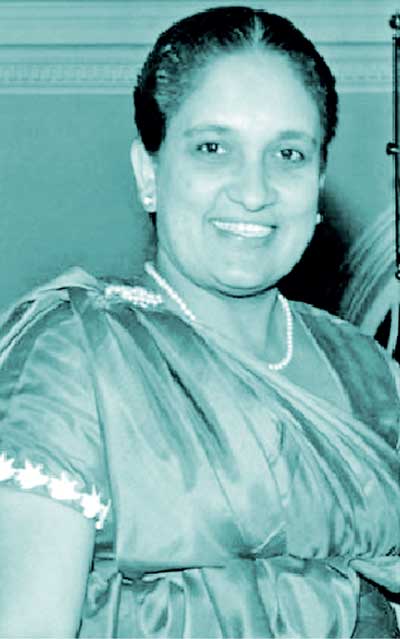Monday Jan 05, 2026
Monday Jan 05, 2026
Monday, 18 April 2016 00:00 - - {{hitsCtrl.values.hits}}
 The 100th birthday of Sirimavo Bandaranaike falls on 17 April 2016. Sirimavo Bandaranaike has been the most charismatic and influential female leader in Sri Lankan politics. Known as Mrs. B, Sirima, Sirimavo or Methini, Mrs. Sirimavo Bandaranaike holds the title of first female Prime Minister of the world.
The 100th birthday of Sirimavo Bandaranaike falls on 17 April 2016. Sirimavo Bandaranaike has been the most charismatic and influential female leader in Sri Lankan politics. Known as Mrs. B, Sirima, Sirimavo or Methini, Mrs. Sirimavo Bandaranaike holds the title of first female Prime Minister of the world.
The late 20th century saw a few remarkable Asian ladies revolutionising the global political arena, pioneering the entry of women into world politics. Mrs. B was one of them, succeeding after her husband and coming to power in an era where women were not eminent in world politics, later followed by leaders like Indira Gandhi from India who was world’s longest-serving woman Prime Minister.
Mrs. B was the successor to Sri Lanka Freedom Party (SLFP) after the assassination of her husband, starting a family lineage of well-known Bandaranaikes in Sri Lankan politics. Her terms in office led to a golden era of Sri Lanka’s foreign relations. She has left unremarkable memories of Sri Lanka in world history with her mediocre foreign policy. She was highly-recognised in politics despite being a woman, a leader with very good diplomatic skills, charisma and charm.
Family
Digging a bit into the history, Sirima Ratwatte was born to Barnes Ratwatte and Rosalind Mahawelatenne Kumarihamy on 17 April 1916, a century ago! She was the eldest daughter of the family of six, with four brothers and one sister. The ancestral family, Ratwattes belonged to an aristocratic background, the Radalas, who stand high in the local caste hierarchy.
The family had hailed from Matale and was well-connected to local politics as one of the ancestors was known to be the signatory on behalf of the Sinhalese to the Kandyan Convention of 1815. Her father Barnes Ratwatte has been a Disawa (local leader) in Sabaragamuwa and her mother coming from a respected lineage of the Mahawelatenne Walauwa in Balangoda.
Sirima has been educated at one of Colombo’s most elite private girl’s schools, St. Bridget’s Convent, and was not a political figure until the demise of her husband. In 1940, at the age of 24, Sirima had married politically-affluent Solomon West Ridgeway Dias Bandaranaike. He was hailing from a political family and was then a member of the State council. He was also the founder of SLFP and later the fourth Prime Minister of Ceylon. Sirima and SWRD had three children – Sunethra, Chandrika and Anura – who are also well known in the Sri Lankan political arena.
Entry into politics
Sirima’s entry into politics was quite sudden, following the demise of her husband, S.R.W.D. Bandaranaike. SWRD was shot on 26  September 1959 by a man dressed in a yellow robe when he was serving as the country’s fourth Prime Minister.
September 1959 by a man dressed in a yellow robe when he was serving as the country’s fourth Prime Minister.
Several key political issues within the SLFP led Sirima to make her way as the legitimate successor of SLFP. One such reason was the leadership vacuum created in SLFP after a sequence of events, especially the 1960 March election defeat under the leadership of Wijeyananda Dahanayake. Within months of SLFP leadership, Sirima led the party to a landslide victory when the SLFP won the 1960 July General Election, taking 75 out of 150 seats and the Dudley Senananayake-led UNP being defeated. Thus, she became the first woman Prime Minister in the world.
It is believed that her pledge to the nation – she would follow the footsteps of her husband and his socialist policies – supported the victory. Moreover, it is believed that promising to bring forth the Sinhala Only Act and carry out repatriation of the estate Tamils to India too played a helping role in securing votes. Being known as the “Weeping Widow” for frequently bursting into tears during the election campaign was also contributory to her fame during this period.
Foreign policy and nationalism
Taking a look at Sri Lankan foreign policy, the post-independent era foreign policy has followed much of a pro-West approach under the rule of the UNP regime until 1956 (D.S. Senanayake – 1948 to 1952, Dudley Senanayake – 1952 to 1953 and Sir John Kotelawala – 1953 to 1956). Nevertheless, in 1956 Sri Lankan foreign policy underwent a significant drift with S.W.R.D. Bandaranaike winning a landslide election, ending the UNP regime of eight years. Unlike the UNP regime, the Bandaranaike regime is supported by the communist and other socialist groups of Sri Lanka, thus it deviates from the pro-West to a more socialist approach, yet neutral in the international arena.

The Bandaranaikes were known as socialists, who described themselves as leaders representing the “little man,” thus they were largely supported by socialist groups in the country. Mrs. B was no different than her husband. Coming to power Mrs. B followed the footsteps of S.W.R.D. Bandaranaike and was principally supported by a strong team of communists in Sri Lanka. She started her journey with the principal of nationalisation of many sectors of the Sri Lankan economy. She nationalised schools, banks, insurance and petroleum. She changed the country’s official language from English to Sinhala and conducted all Government business in Sinhala.
The policy of nationalism led to the deterioration of relationship with the West. The relationship with the USA deteriorated due to nationalisation of oil importation and distribution in Sri Lanka. The oil monopoly of Sri Lanka after independence was mainly held by the West accounting for 80% of Sri Lanka’s oil requirement. The importation and distribution of oil in Ceylon was handled by two American companies – Caltex and Standard Vacuum American and Shell, a British company. As a result the prices of oil were subjected to sky rocketed monopolistic prices.
In reducing the import cost of oil to Sri Lanka whilst saving foreign exchange, the Sirimavo Government established the Ceylon Petroleum Corporation in 1961. By 1 January 1964 Ceylon Petroleum Corporation came into effect in as the sole and exclusive right to import, export and distribute specified petroleum products in Sri Lanka, breaking down the monopoly of Western oil companies and partially taking them over, facing repercussions as suspended of foreign aid by USA in return.
Thus, the pro-West nature of Sri Lankan politics in the previous UNP regime changed even though the Bandaranaikes were not considered anti-West. As a result, Mrs. Bandaranaike moved closer to China and the Soviet Union. Mrs. B during her tenures made several visits to China where China had a unique say in her relations.
Mrs. B’s mediation in the China-India border dispute was a remarkable milestone in world history that illustrated her close companionship with both countries as well as her good diplomatic skills. Hence, she played a neutral role as an arbitrator to end the China and India border dispute in 1962. It became an easy task to take both parties to negotiable table due to the cordial relationship she maintained with these two countries and the high regard she had from both these countries.
The foreign policy started by S.W.R.D. Bandaranaike, later followed by Mrs. Bandaranaike is known as neutral. S.W.R.D. Bandaranaike believed in “friends of all and enemies of none,” not aligned to any power bloc in the dawn of a cold war. The Bandaranaike regime was able to make Sri Lanka stand out in world politics as an influential independent nation with neutralism coming close with nonaligned policy.
Non-Aligned Movement
The Non-Aligned Movement (NAM) came to play in the light of the Cold War. NAM is a group of states which are not formally aligned with or against any of these major power blocs. It was founded in Belgrade in 1961, and was largely conceived by India’s first Prime Minister Jawaharlal Nehru, Indonesian President Sukarno, Egyptian President Nasser, Ghana’s President Kwame and Yugoslavia’s President Tito.
Mrs. Bandaranaike’s role in NAM was highly respected and accepted by the world leaders. She was chosen as the Chairman of the Non-Aligned Movement and hosted the fifth summit in Sri Lanka from 16 to 19 August 1976 with the participation of numerous heads of state. To this day it is believed to be the largest event hosted in Sri Lanka, attended by most of the world leaders.
She was gathering popularity as a world leader and enjoyed continued success in foreign affairs unlike any other Sri Lankan leader in the past. Her diplomatic ties extended worldwide, where Sri Lanka commenced diplomatic relations with Egypt, Nepal, Soviet Union, China and Poland. Sri Lankan benefited from her close liaison with several countries by receiving “gifts” of new industrial plants to Sri Lanka such as Kelani Tyre factory, Textile factory and the Bandaranaike Memorial International Conference Hall (BMICH).
Mrs. Bandaranaike’s relations with India were special. India being the super power of South Asia, she maintained close links with India as well as the governing Nehru family. Harnessing her close ties with India, she took steps to deport estate workers migrated to Sri Lanka to work in plantations during the British rule. After negotiation with Indian Prime Minister Lal Bahadur Shastri, she signed the Sirima-Shasthri Pact in 1964 to grant Ceylonese citizenship to 300,000 of the Indian population in Sri Lanka, while 525,000 would be repatriated to India which later in time did not have complete success.
The Kachchathivu agreement was another significant pact signed during Mrs. B’s regime. Ownership of the Kachchathivu Island was a controversy until 1974 when the island was administered by both countries. Nevertheless after negotiations, Mrs. B signed an agreement known as the Sirima-Indira pact, recognising the ownership of Kachchathivu to Sri Lanka despite the opposition from South India.
Mrs. B has her contributions to world politics in her own way. She declared the Indian Ocean a Peace Zone at the Non Aligned Movement Conference held in Lusaka, the reason being Diego Garcia, an atoll located south of the equator in the central Indian Ocean used by the USA as a Navy Base in the late sixties. This was a potential threat to shipping routes from Asia to Europe Middle East and Africa. Therefore, with the approval NAM, Sri Lanka initiated the Declaration of the Indian Ocean as a Zone of Peace to the agenda of the 26th UN General Assembly in 1971.
Challenges and difficulties
Leaving international fame aside, Mrs. B faced great challenges and difficulties as a political leader on home soil compared to many other local leaders. The initial challenges came her way at the beginning of her political career with a significant coup against the Government. Next was in 1971, a year into her second term in office, when youth movements came forth with arms. Yet, it is believed that Mrs. B had faced those challenges much better than a mature politician.
The final challenge came her way, giving her a long pause from politics when her civil rights were taken away in 1977 by the rule of J.R. Jayewardene, keeping her out of politics for many years. She was not given any opportunity to return to politics until her daughter led a collation to victory in 1994. However, Mrs. B is remembered even today as the first female Prime Minister in the world and the leader who gave Sri Lanka due recognition in the international political arena.
(The writer can be reached via [email protected].)